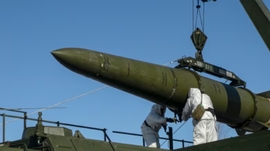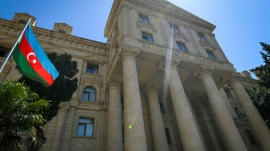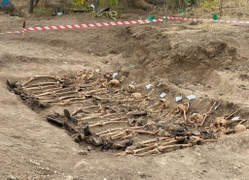Tension between the West and Russia has escalated in the run-up to NATO exercises that will soon kick off in the Arctic, meant to simulate the alliance’s collective response to an armed attack against a member country.
“The escalation of NATO’s military and political activity in the Arctic region, namely, in the immediate vicinity of Russia on the territory of northern Norway, hasn’t gone unnoticed,” Russian Foreign Ministry Spokesperson Maria Zakharova said last week, according to TASS.
“We have to state that such irresponsible actions will inevitably destabilize the military and political situation in the north, increase tensions and undermine the fabric of Russian-Norwegian relations.”
Dubbed Trident Juncture 2018, the exercise consists of 40,000 troops from 30 countries that will simulate the defense of a NATO member state from a fictional foe. This will be NATO’s largest exercise since 2015. Norway and Iceland are serving as host nations.
Russia shares land borders with Norway in the far northern reaches of the country, located northeast of Finland, near which the exercises will take place. Oslo’s decision to double the presence of U.S. Marines for the exercise and allow for the northward military expansion is perceived by Moscow as hostile.
Sensitivities about the Arctic run high in Moscow. Russia’s Northern Fleet has its main base in Severomorsk, about 100 kilometers from the border with Norway on the Kola Peninsula, which is dotted with Russian naval bases and restricted military zones.
However, NATO has invited all Organization for Security and Cooperation in Europe (OSCE) member states, including Russia, to send observers to Trident Juncture for the sake of transparency, which could help quell any suspicion that the exercises are a pretext for military aggression. NATO’s Secretary General Jens Stoltenberg called this year’s military drills the biggest maneuvers since the Cold War.
“The exercise is defensive, and it is transparent,” Stoltenberg told reporters on Tuesday following a meeting of defense ministers at the new Brussels headquarters.
Russia’s foreign ministry responded, saying that whatever is the verbal camouflage, leading NATO countries are building up their military presence in the region directly bordering Russia. The Kremlin believes that the Arctic and northern Europe “must remain a low-tension zone.”
“Reckless saber-rattling in this previously calm region can have far-reaching consequences, and not through any fault of ours,” Zakharova said.
NATO believes that Russia, which recently hosted Vostok 2018 in the Pacific – the country’s largest show of power in 40 years – is building up capacity in the Arctic to gain access and possibly claim the region’s valuable oil, gas and control shipping routes. The alliance is particularly concerned about the increasing number of Russian military bases in the Arctic, which can limit the freedom of navigation there for NATO member states.
“We see that there is no reason to believe that potential tension could start in the Arctic, but it could easily end up here if it starts elsewhere,” Norwegian Foreign Minister Ine Eriksen Soereide told Reuters. “And that is of course due to Russia building up their military capacity, especially on the Kola Peninsula.”
Trident Juncture, which runs October to November, will include the use of 130 aircraft, 70 vessels and around 10,000 land vehicles. While the drills are considered the biggest such movement of NATO personnel and vehicles since the Soviet Union’s collapse in 1991, it will be smaller than Vostok 2018, also known as East 2018, staged by Russia and China last month, according to NATO’s Secretary General.







 The modernized and expanded Georgian segment of the Baku-Tbilisi-Kars (BTK) railway is set to recommence freight operations this month.
The modernized and expanded Georgian segment of the Baku-Tbilisi-Kars (BTK) railway is set to recommence freight operations this month.
 The Azerbaijani government has rejected the recent claims made by French Interior Minister Gérard Darmanin, who accused Baku of fostering separatis...
The Azerbaijani government has rejected the recent claims made by French Interior Minister Gérard Darmanin, who accused Baku of fostering separatis...
 As of April 27, additional 48 bodies were unearthed in the liberated lands of Azerbaijan, bringing the total count of discovered remains to over 600.
As of April 27, additional 48 bodies were unearthed in the liberated lands of Azerbaijan, bringing the total count of discovered remains to over 600.
 Ulviyya Fataliyeva, a female Azerbaijani chess grandmaster, was crowned this week at the European Women’s Chess Championship (EWCC) in Rhodes, Gree...
Ulviyya Fataliyeva, a female Azerbaijani chess grandmaster, was crowned this week at the European Women’s Chess Championship (EWCC) in Rhodes, Gree...
 President Ilham Aliyev praised Azerbaijan’s cultural diversity as a key factor in fostering peace, stability, and unity within the country, where a...
President Ilham Aliyev praised Azerbaijan’s cultural diversity as a key factor in fostering peace, stability, and unity within the country, where a...
 Azerbaijan, Uzbekistan, and Kazakhstan are planning to merge their energy systems following a historic memorandum of understanding (MoU) signed by ...
Azerbaijan, Uzbekistan, and Kazakhstan are planning to merge their energy systems following a historic memorandum of understanding (MoU) signed by ...



